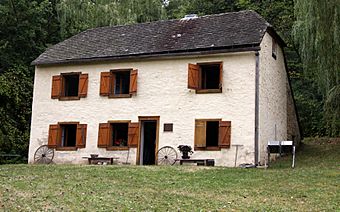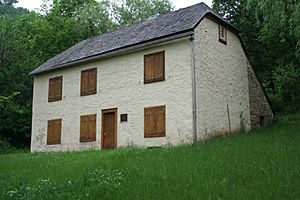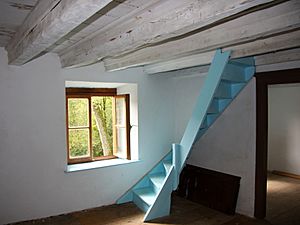Nicholas Marnach House facts for kids
The Nicholas Marnach House is an old house that was once home to a family from Luxembourg. It is located in Whitewater Township, Minnesota. The house was built between 1857 and 1860.
It is on a special list called the National Register of Historic Places. It was added to this list in 1978. The house is important because of its unique building style. It also shows how people settled in this area long ago. It is one of the oldest buildings in Southeast Minnesota built in a traditional European style. This style was common for people who came from Germany.
The house is about 3 miles (4.8 km) north of Elba, Minnesota. It is inside the Whitewater Wildlife Management Area. This area is a state wildlife preserve. It is also right next to Whitewater State Park.
Contents
What the House Looks Like
The Nicholas Marnach House is a two-story building. It is shaped like a rectangle. It has a small addition called a "lean-to" at the back. This part is built into a hillside.
The house has an attic under a special kind of roof. This roof is called a half-hip roof. There is also a partial basement under the east side of the house. The walls are very thick, up to 3 feet (0.91 m) wide. They are made of limestone covered with thick stucco.
Each floor has three rooms. Every room has a large square window facing south. Narrow stairs connect the different floors. The attic has smaller windows on each end. It even has a layer of concrete on the floor. This was done to help prevent fires.
The house is built in a style called Quereinhaus. This style became popular in Luxembourg in the 1840s. It uses old building ideas from medieval times. These ideas include strong timber frames and massive stone walls. Other features are stucco on the outside, square windows, and the half-hip roof.
History of the Marnach House
John and Mary Marnach, along with their son Nicholas, came from a town called Rambrouch in Luxembourg. Many people from Luxembourg settled in places like Elba and Rollingstone. These towns are in Winona County.
Most settlers built simple homes. But the Marnach family chose to build their house using older methods. These methods were common in medieval Germany. The family were farmers and also skilled stonemasons. They built their home in four steps between 1857 and 1860.
The house was on a stagecoach road back then. This road connected Minneiska and Plainview, Minnesota. The house was part of a town that no longer exists, called Whitewater Falls. In 1914, a wooden lean-to was added to the back of the house.
People lived in the house for many years. But by the mid-1900s, it was empty. It was added to the National Register of Historic Places in January 1978.
Later, people who were descendants of the early settlers worked to save the house. It was starting to fall apart. They got help from the government of Luxembourg. Even schoolchildren in Luxembourg collected money to help.
From 1991 to 1993, skilled workers from Luxembourg came to help. They worked with local volunteers to fix up the Marnach House. They replaced the roof, doors, and windows. They also rebuilt part of the west wall. Inside, they replastered the walls and put in new floors.
On August 12, 1993, the restored house was officially opened. A special ceremony was held. The former prime minister of Luxembourg, Pierre Werner, was there.
Why the House is Important
The Nicholas Marnach House is special. It is the only stone farmhouse of its kind and size in Southeast Minnesota. It is also the oldest known example of traditional European building. This style was used by the first settlers in the area.
The house shows us about the Germanic immigrants who came to this region. It is also a rare example of northern European architecture. It was brought to a new place that had a similar environment.
How to Visit the House
The Nicholas Marnach House is on public land. It is in a state wildlife area. You can walk to the house all year round. Sometimes, there are special public events. These events might offer wagon or sleigh rides to the house. You can also get guided tours inside the house during these times.






